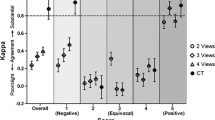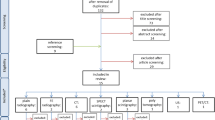Abstract
Purpose
The accurate diagnosis of spondylolysis is widely made with CT scan considered as the gold standard. However, CT represents significant radiation exposure particularly substantial in a young and sometimes still growing population. Although the role of MRI in identifying edema/inflammation within the pars as an active lesion is proved, its ability to demonstrate and classify pars fracture line as same as CT is still controversial. This meta-analysis aimed to determine sensitivity and specificity of MRI in the direct visualisation of the pars defect.
Methods
The PubMed and Embase databases were systematically searched for relevant studies from the earliest researchable time to December 2016 for cases in which the accuracy of MRI was reported for the diagnosis of spondylolysis in young patients. Two reviewers independently assessed the methodological quality for each selected study using the quality assessment of diagnostic accuracy studies 2 tool. A meta-analysis of the reported sensitivity and specificity of pooled data of selected studies was performed by a systematic review. For each selected study, sensitivity and specificity was recalculated, by considering only direct visualisation of a fracture line of the pars. The hierarchic summary receiver operating characteristic curve was generated to estimate the diagnostic performance of MR imaging. Heterogeneity was also tested.
Results
The systematic review identified 4 out of a total of 1300 studies to be included in the meta-analysis. On a per-pars basis (a total of 1122 pars), the pooled sensitivity and specificity of the MRI for the direct diagnosis of a pars defect were 81% (95% CI 54–94%) and 99% (95% CI 98–100%), respectively. A high overall heterogeneity (I2 = 79.5%) was computed with respective high and low heterogeneity on sensitivity (I2 = 87.9%) and specificity (I2 = 38.4%).
Conclusions
This meta-analysis demonstrated a high diagnostic performance of MR imaging for the diagnosis of a pars defect in young adults. This technique may be considered as a first-line imaging technique as it helps to avoid exposure to ionising radiation.



Similar content being viewed by others
References
Grogan JP, Hemminghytt S, Williams AL et al (1982) Spondylolysis studied with computed tomography. Radiology 145:737–742
Ralston S, Weir M (1998) Suspecting lumbar spondylolysis in adolescent low back pain. Clin Pediatr (Phila) 37:287–293
Fredrickson BE, Baker D, McHolick WJ et al (1984) The natural history of spondylolysis and spondylolisthesis. J Bone Jt Surg Br 66:699–707
Iwamoto J, Abe H, Tsukimura Y, Wakano K (2004) Relationship between radiographic abnormalities of lumbar spine and incidence of low back pain in high school and college football players: a prospective study. Am J Sports Med 32:781–786
Sakai T, Yamada H, Nakamura T et al (2006) Lumbar spinal disorders in patients with athetoid cerebral palsy. Spine (Phila Pa 1976) 31:E66–E70
Micheli LJ, Wood R (1995) Back pain in young athletes. Significant differences from adults in causes and patterns. Arch Pediatr Adolesc Med 149:15–18
Blanda J, Bethem D, Moats W, Lew M (1993) Defects of pars interarticularis in athletes: a protocol for nonoperative treatment. J Spinal Disord 6:406–411
Miller SF, Congeni J, Swanson K (2004) Long-term functional and anatomical follow-up of early detected spondylolysis in young athletes. Am J Sports Med 32:928–933
Herman MJ, Pizzutillo PD (2005) Spondylolysis and spondylolisthesis in the child and adolescent: a new classification. Clin Orthop Relat Res 434(5):46–54
Langston JW, Gavant ML (1985) “Incomplete ring” sign: a simple method for CT detection of spondylolysis. J Comput Assist Tomogr 9:728–729
Harvey CJ, Richenberg JL, Saifuddin A, Wolman RL (1998) The radiological investigation of lumbar spondylolysis. Clin Radiol 53:723–728
Congeni J, McCulloch J, Swanson K (1997) Lumbar spondylolysis. A study of natural progression in athletes. Am J Sports Med 25:248–253
Galanski M, Nagel HD, Stamm G (2007) Results of a federation inquiry 2005/2006: pediatric CT X-ray practice in Germany (article in German). RoFo 179:1110–1111
Yamaguchi KT, Skaggs DL, Acevedo DC et al (2012) Spondylolysis is frequently missed by MRI in adolescents with back pain. J Child Orthop 6:237–240
Moher D, Liberati A, Tetzlaff J et al (2009) Preferred reporting items for systematic reviews and meta-analyses: the PRISMA statement. PLoS One 6:e1000097
Pai M, McCulloch M, Gorman JD et al (2004) Systematic reviews and meta-analyses: an illustrated, step-by-step guide. Natl Med J India 17:86–95
Delavan JA, Stence NV, Mirsky DM et al (2016) Confidence in assessment of lumbar spondylolysis using three-dimensional volumetric T2-weighted MRI compared with limited field of view, decreased-dose CT. Sport Heal A Multidiscip Approach 8:364–371
Ang EC, Robertson AF, Malara FA et al (2016) Diagnostic accuracy of 3-T magnetic resonance imaging with 3D T1 VIBE versus computer tomography in pars stress fracture of the lumbar spine. Skelet Radiol 45:1533–1540
Whiting PF, Rutjes AWS, Westwood ME et al (2011) QUADAS-2: a revised tool for the quality assessment of diagnostic accuracy studies. Ann Intern Med 155:529
Schneiders AG, Sullivan SJ, Hendrick PA et al (2012) The ability of clinical tests to diagnose stress fractures: a systematic review and meta-analysis. J Orthop Sport Phys Ther 42:760–771
Reitsma JB, Glas AS, Rutjes AWS et al (2005) Bivariate analysis of sensitivity and specificity produces informative summary measures in diagnostic reviews. J Clin Epidemiol 58:982–990
Higgins JPT, Thompson SG, Deeks JJ, Altman DG (2003) Measuring inconsistency in meta-analyses. BMJ 327:557–560
Rutter CM, Gatsonis CA (2001) A hierarchical regression approach to meta-analysis of diagnostic test accuracy evaluations. Stat Med 20:2865–2884
Rush JK, Astur N, Scott S et al (2015) Use of magnetic resonance imaging in the evaluation of spondylolysis. J Pediatr Orthop 35:271–275
Campbell RSD, Grainger AJ, Hide IG et al (2005) Juvenile spondylolysis: a comparative analysis of CT, SPECT and MRI. Skelet Radiol 34:63–73
Ganiyusufoglu AK, Onat L, Karatoprak O et al (2010) Diagnostic accuracy of magnetic resonance imaging versus computed tomography in stress fractures of the lumbar spine. Clin Radiol 65:902–907
Masci L, Pike J, Malara F et al (2006) Use of the one-legged hyperextension test and magnetic resonance imaging in the diagnosis of active spondylolysis. Br J Sports Med 40:940–946 (discussion 946)
Yamane T, Yoshida T, Mimatsu K (1993) Early diagnosis of lumbar spondylolysis by MRI. J Bone Jt Surg Br 75:764–768
Johnson D, Farnum G, Latchaw R, Erba S (1989) MR imaging of the pars interarticularis. Am J Roentgenol 152:327–332
Grenier N, Kressel HY, Schiebler ML, Grossman RI (1989) Isthmic spondylolysis of the lumbar spine: MR imaging at 1.5 T. Radiology 170:489–493
Saifuddin A, Burnett SJD (1997) The value of lumbar spine MRI in the assessment of the pars interarticularis. Clin Radiol 52:666–671
Ulmer JL, Mathews VP, Elster AD et al (1997) MR imaging of lumbar spondylolysis: the importance of ancillary observations. Am J Roentgenol 169:233–239
Campbell RS, Grainger AJ (1999) Optimization of MRI pulse sequences to visualize the normal pars interarticularis. Clin Radiol 54:63–68
Ishibashi Y, Okamura Y, Otsuka H et al (2002) Comparison of scintigraphy and magnetic resonance imaging for stress injuries of bone. Clin J Sport Med 12:79–84
Sairyo K, Katoh S, Takata Y et al (2006) MRI signal changes of the pedicle as an indicator for early diagnosis of spondylolysis in children and adolescents: a clinical and biomechanical study. Spine (Phila Pa 1976) 31:206–211
Kobayashi A, Kobayashi T, Kato K et al (2013) Diagnosis of radiographically occult lumbar spondylolysis in young athletes by magnetic resonance imaging. Am J Sports Med 41:169–176
Murray CJL, Vos T, Lozano R et al (2012) Disability-adjusted life years (DALYs) for 291 diseases and injuries in 21 regions, 1990–2010: a systematic analysis for the Global Burden of Disease Study 2010. Lancet 380:2197–2223
Acknowledgements
The authors wish to express their gratitude to the experienced research librarian Mrs. Mafalda Burri for his technical assistance to perform the search strategy of the comprehensive literature.
Author information
Authors and Affiliations
Corresponding author
Ethics declarations
Funding source
No funding was secured for this study. The authors have no financial relationships relevant to this article to disclose.
Conflict of interest
The authors have no conflicts of interest to disclose.
Rights and permissions
About this article
Cite this article
Dhouib, A., Tabard-Fougere, A., Hanquinet, S. et al. Diagnostic accuracy of MR imaging for direct visualization of lumbar pars defect in children and young adults: a systematic review and meta-analysis. Eur Spine J 27, 1058–1066 (2018). https://doi.org/10.1007/s00586-017-5305-2
Received:
Revised:
Accepted:
Published:
Issue Date:
DOI: https://doi.org/10.1007/s00586-017-5305-2




